#and the flashbacks during missy’s private moment
Explore tagged Tumblr posts
Text
there’s no way i just sobbed to young sheldon
#literally george’s death is mentioned all throughout tbbt and here i am#mary’s speech:(#‘this wasn’t supposed to happen’#and the flashbacks during missy’s private moment#i can’t do this today#young sheldon#george cooper
36 notes
·
View notes
Photo
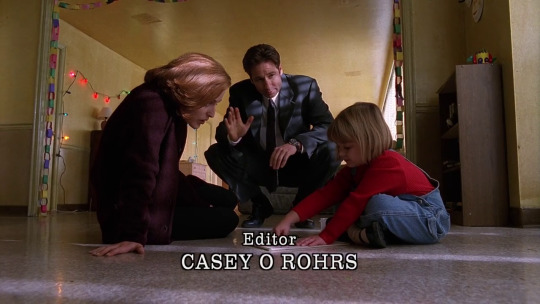
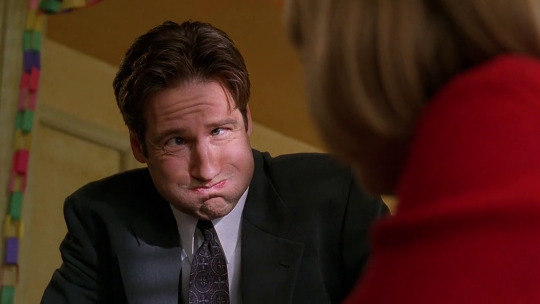
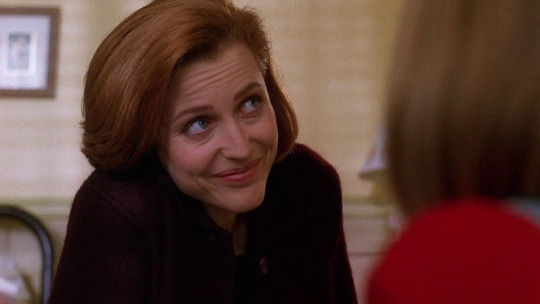
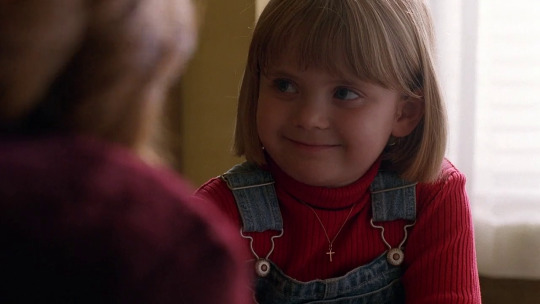
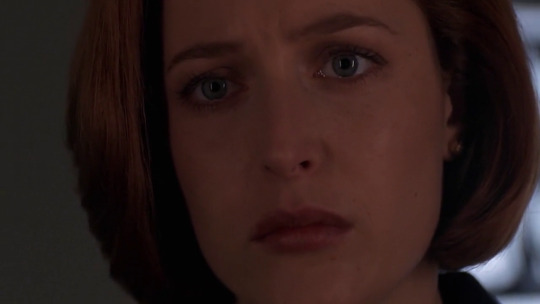
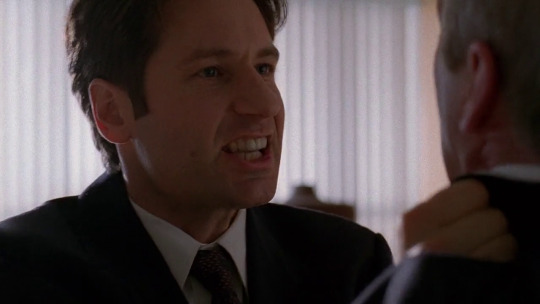
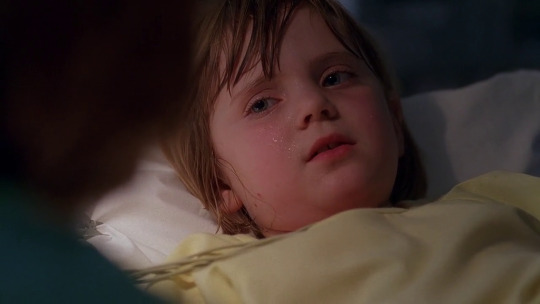
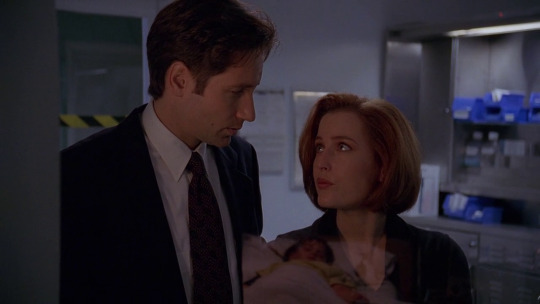
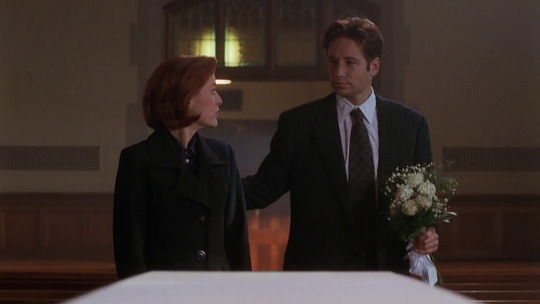
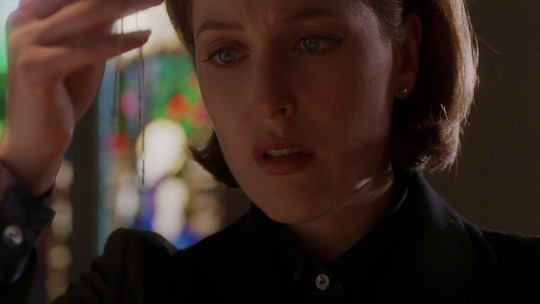
5x07. “Emily” (part 2 of 2) - X-Files Rewatch
This... is an extremely long post. It not only involves "Emily" analysis but some creative thinking surrounding "Per Manum" from season 8, due to some inconsistencies surrounding the storylines in both. I think I have a fix though!
Scully's dream - walking by herself on some sort of desert - "Alone, as ever." I refuse to use the word that gets used in this series while talking about Scully's fertility here, even though I think this scene is is meant to allude to it. Gross.
It's one thing for Scully to have the knowledge that she cannot conceive and to think she has the possibility of adopting her sister's child. It's quite another to discover that Emily is hers, and possibly the only child that will ever be hers, and that she was created unwillingly out of trauma. 😥
She doesn’t hesitate to call Mulder. She needs to find out Emily's history, needs to KNOW to have power over it. She doesn't care too much about the implications - what led her to her daughter, hearing her sister's voice. It doesn't matter, all that she cares about is Emily.
I love that Scully told Emily about Mulder before he got there. He's important to her and will be just as much a part of Emily's life as he is in Scully's. I wonder what she told her?
The picture of Mulder seeing the two of them on the floor together. Emily's grin is eerily similar to Scully's. What must Mulder be thinking?
He's so good with kids, too. Wish we'd seen more daddy Mulder. Such a waste.
Mulder calls her out on why she didn't call him sooner. He's starting to push a bit more, be a bit more demanding and critical when she does things that don't make sense (but that he knows are pushing the boundaries for her in terms of her belief).
Scully wanting him as a witness in her adoption hearing. But Mulder says he should have declined because he doesn't want to see her hurt. 😥 He has a feeling this can only end badly.
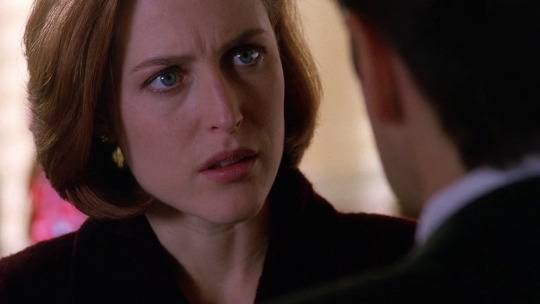

Really shitty of Mulder to reveal the fact that he knew that Scully's ova were harvested during her abduction for the first time IN FRONT OF A JUDGE. Whyyyyy didn't he tell her this... oh, y'know... on the way over? So she's not sitting there with her mouth open completely vulnerable and exposed? it was necessary to tell the judge so that it would support Scully's adoption - that things were forcibly removed from her and then experimented with to create Emily. But he SHOULD HAVE TOLD HER BEFORE THIS. (I talk about this more in my analysis at the end.)

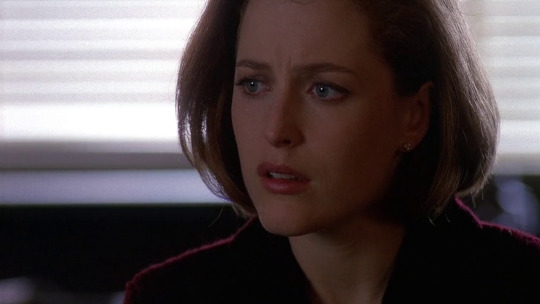
Scully looking back at Mulder in relief that Emily's still there, cut short by realizing she's sick. Mulder immediately taking her in his arms. 😥
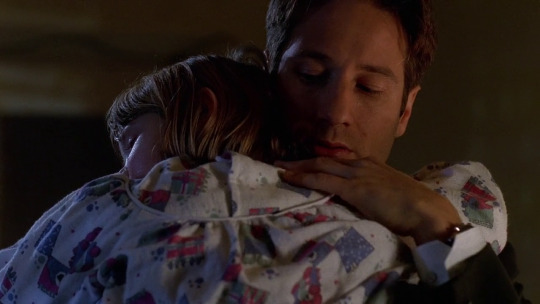
"Are you two the parents?"
he subtle looks between themselves
then Scully saying she's the mother, even though its complicated - what else can she say without telling a stupidly long and complicated story?
Scully grasping Mulder's shoulder at the window & standing close, seeing what is happening with Emily in the room. Poor Emily, all alone in the room, causing someone else to be sick. 😥
Mulder going to Dr. Calderon and doing what he does (frustration manifesting as physical violence) while Scully stays by Emily's side.
"I want everything to help that little girl."
Scully in a mask. Her tenderness 😥 Her heart breaking when she has to put Emily in a scary situation - the sound of the machine.
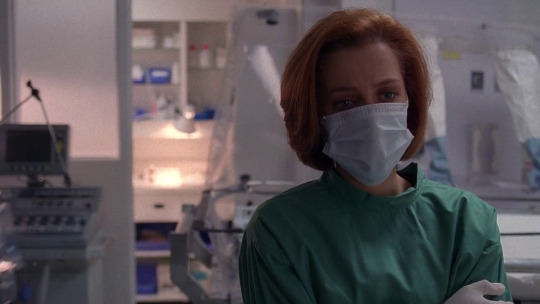
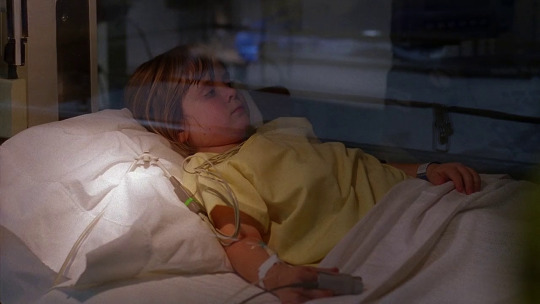
The idea that she's found a child but now she's dying and will lose her. D:>
Threatening the social worker - ensuring she can still make decisions about Emily. Though she's not the most objective, she has the most knowledge about the strangeness surrounding her.
God Emily is so stinkin' cute. Scully makes cute babies.

Standing close outside Emily's room. Wanting to reassure Mulder despite what she's going through. HUG HER DAMNIT (though she'd probably not want him to right now).
He puts his arm around her, says he'll stay but Scully wants to be alone.
she doesn't want to be around him when she breaks down
this isn't about him, she can't spare any energy worrying about him
she can't let him in yet. Doesn't think he thinks of her in a romantic way and can't let him in out of pity. Needs to stay strong. Also she's pissed at him (see below).
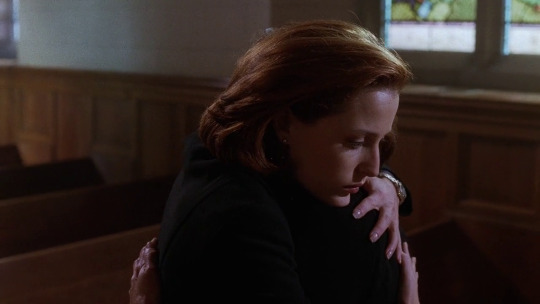
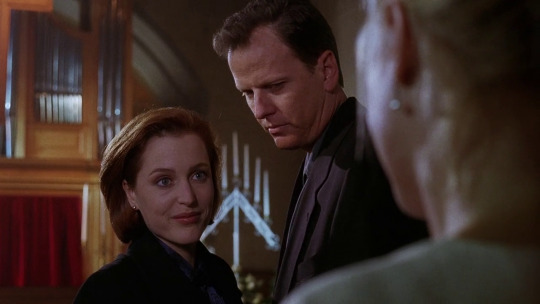
At the funeral, Mulder wanting to comfort. Gazing.
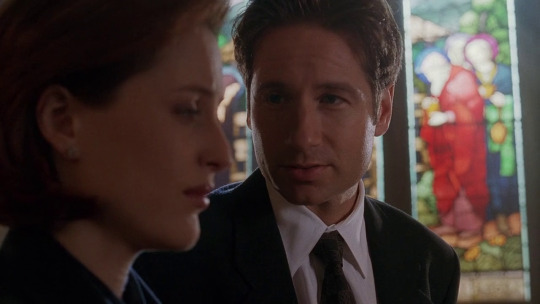
Deep dive Emily analysis/fix. (Also “Per Manum” stuff.)
So there’s a contradiction in Emily/Per Manum. As written, both episodes contradict each other.
EMILY (Adoption Hearing for Emily) MULDER: She was missing for 4 weeks, that's documented in the file. JUDGE: And you found evidence that during this time, she was subjected to experiments where ... you say, they extracted her ova? MULDER: Yes, all of them. (Scully is stunned.)
(LATER ON.) SCULLY: Why didn't you tell me, Mulder? MULDER: I never expected this. I thought I was protecting you.
PER MANUM (Elevators of FBI Building) SCULLY: I was left unable to conceive with whatever test that they did on me. And I am not ready to accept that I will never have children. MULDER: Scully, there's, um, there's something I haven't told you either and I hope you, uh, forgive me and understand why I would have kept it from you. SCULLY: What? MULDER: During my investigation into your illness I found out the reason why you were left barren. Your ova were taken from you and stored in a government lab.
Events of Per Manum deal with the EXACT SAME CONVERSATION but in a MUCH LESS SHITTY manner (well, except for the use of the word "barren"). Mulder tells her what he knows in private, and is apologetic. The question being, which came first? Is Per Manum unreliable because it's a memory? Doesn't seem likely that Scully would forget exactly what happened, but it seems that it is the only possibility. Perhaps instead of telling Mulder straight out about not being able to conceive she only tells him about not wanting to accept it. Therefore Emily happens first then Per Manum. And once we get there in the series I’ll reveal when I think the flashback occurred (it’s within season 5).
EDITED/FIX’D PER MANUM SCENE:
SCULLY: I was left unable to conceive with whatever test that they did on me. And I am not ready to accept that I will never have children. MULDER: Scully, there's, um, there's something I haven't told you either and I hope you, uh, forgive me and understand why I would have kept it from you. SCULLY: What? MULDER: During my investigation into your illness I found out that your the reason why you were left barren. Your ova were taken from you and stored in a government lab.
(This also has the bonus of removing Mulder saying “that word” so yeah.
The reason for the extra stuff in Per Manum is just pure laziness, not wanting to re-explain to people who didn't remember stuff from Emily, not wanting to have additional flashbacks to the episode to save time.
The adoption hearing is where Scully shuts herself away from Mulder. She wanted more from him, wanted a second chance. With Emily, perhaps her priority shifted to her daughter, but she wanted Mulder included in whatever that relationship ended up being. When she learns that Mulder kept all of this from her, it is a very large step backwards. Scully won't initiate anything not only out of fear that Mulder doesn't feel the same, fear of a deeper connection, but also because he PISSED HER OFF.
Hiding knowledge from Scully is very bad. She NEEDS TO KNOW, in order to have power over terrible things that are done to her. She goes into pathology to have power over death and dying. She focuses on finding out what happened to her when she was abducted, despite being recently returned, needing to know to have power over her fears about it. That he withheld these things from her takes away her power/her control over them.
At her brother's house, sitting on the couch unusually far away from each other.
Why didn't you tell me, Mulder? - Scully I never expected this. I thought I was protecting you. - Mulder
Anything else that might need to be said is interrupted by a phone call. Emily needs their help.
Scully wants to say more, wants to call him out for why his actions hurt her so much, but her focus switches immediately to Emily, on being there for her, instead of thinking too deeply about anything else. Also, Scully needs Mulder's help, and he did come from a place of wanting to protect her, so she focuses on who the "real" enemies are at the moment. These facts do not excuse the shitty things Mulder did, but provide a reason for her to ignore it for the moment.
Scully folds in on herself after losing Emily. It will be a while before she can open up to Mulder, to anyone. DISTANCES HERSELF because she needs to heal, needs to go back to the safely and familiarity of JUST work. She CANNOT risk any more right now. She's be extremely hesitant to open up again. She's regressed emotionally to where she was before her cancer diagnosis, probably WORSE.
Scully's fears came true. Her fear of death/loss once she opened herself up.
She takes a chance on the little girl, Missy's voice and her instincts causing her to pursue the investigation - all she learns is that when she takes a chance, when she believes in something other than the expected, all she gets is pain and sorrow. (Although she wouldn’t trade having known Emily for anything, the experience is a terrible one to have to go through.)
#xfiles#x-files#x-files rewatch#x files rewatch#msr#msrheadcanon#mulder and scully#fox mulder#dana scully#season 5#emily#vince gilligan#(+other writers)
67 notes
·
View notes
Text
Black Designer Profile: Stephen Burrows
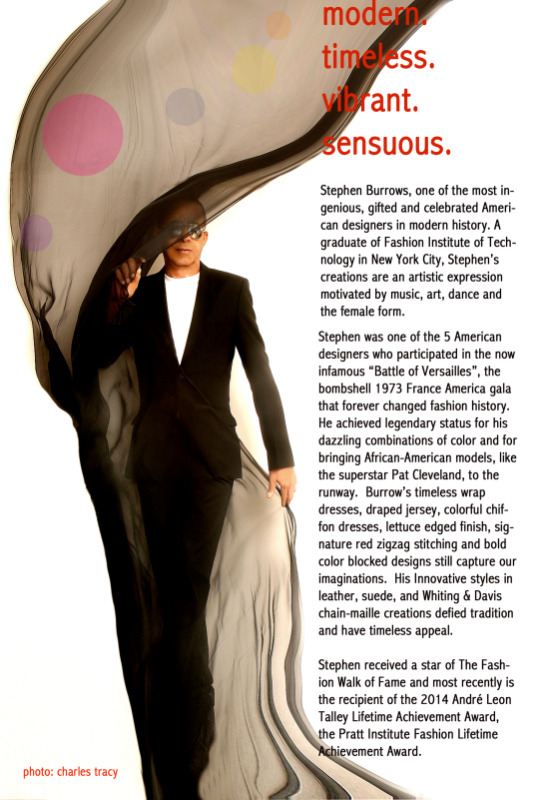
from Stephen Burrow’s website
Stephen Burrows Looks Back as Retrospective Bows
The designer did not seem to be the least bit wistful, frazzled or reflective about being surrounded by his past.
The following text is copied from WWD
By Rosemary Feitelberg
Stephen Burrows made sure that The Supremes’ “Up The Ladder to the Roof” will be piped into the retrospective of his work that bows Thursday night at the Museum of the City of New York.
Aside from it being a favorite song he liked to blast, it could double as an anthem for his career. Fittingly, the exhibition is called “Stephen Burrows: When Fashion Danced.” And dance he did, regardless if it was to Motown, rhythm and blues, New York sound or rock ’n’ roll. The music, like the up-until-dawn club scene he was once part of, has fueled his creativity as much as the buzz and street life he finds so stimulating about New York City.
This story first appeared in the March 20, 2013 issue of WWD. Subscribe Today.
As 25 helpers scrambled about on Tuesday afternoon pinning muslins, rolling on photographs like wallpaper and setting display text, Burrows did not seem to be the least bit wistful, frazzled or reflective about being surrounded by his past. (Never mind that he has spent the better part of the last six weeks helping to track down and select 50 pieces for the show.) Other flashbacks could be heard loud and clear in a documentary about the 1973 “Battle of Versailles” between French and American designers, of which Burrows was one. “It’s humbling to have so much attention. Usually something like this doesn’t happen until you pass,” he said. “Being successful is being happy in what you’re doing and being able to make money at something that you love to do. I can’t imagine anything that makes you happier than finding true love.”
Born in Newark to divorced parents, Burrows has always thought of himself as “bicoastal” in that he always traveled between his mother’s New Jersey home and his father’s Harlem one. After graduating from the Fashion Institute of Technology, his senior co-op job at the missy blouse company Weber Originals turned into a full-time one. “I was making $125 a week. That was a fortune back then,” he said.
By 1968, he had ventured out on his own thanks to private clients like the Brazilian artist Jim Valkus, Bobby Breslau and Roz Rubenstein. In 1970, his Fire Island friend Joel Schumacher — a Henri Bendel-er before he hit Hollywood — suggested he meet with the store’s then-president Geraldine Stutz and a 12-year alliance was formed. Hardworking as he was, Burrows ran with a fast crowd, including Pat Cleveland, Alva Chinn, Halston, Joe Eula and Elsa Peretti. After an after-dinner nap, Burrows would get up around 11 to hit the clubs with his friends — The Loft, Sanctuary and others. At 3 or 4 a.m., they would head home for a few hours sleep before going to work. Burrows said, “We didn’t really talk about fashion unless to tell someone we loved what they were wearing that they had made. It was mostly about dancing and the nightlife. Music was a big force.”
Alcohol and drugs were other forces too, though Burrows didn’t go into detail about those aspects of the period. “We were a product of the times. All that stuff was around, available and taken into account when needed,” he said.
Standing in the Target-sponsored Commune section of his retrospective, which plays up his disco-era rainbow-colored designs, Burrows said he is partial to the early days. The show opens with a colorful photo of Grace Jones snarling opposite a black-and-white one of a bespectacled Burrows wearing a Jell-O printed shirt. Eyeing an image of his first photo shoot in Central Park in 1970, Burrows said the Seventies were all about freedom of expression. That same year he became the first African-American designer to win a Coty Award. “It didn’t matter who you were with as long as you were happy,” he said. Gesturing towards framed sketches and vibrant knitwear, Burrows said, “I’ve always had a thing for phallic symbols. It’s kind of a signature.”
Others know him for joining Halston, Bill Blass, Oscar de la Renta and Anne Klein in the “Battle of Versailles,” the legendary fashion showdown with Yves Saint Laurent, Christian Dior, Hubert de Givenchy, Pierre Cardin and Emanuel Ungaro. “It was such a proud moment for American fashion,” Burrows said. “Of course, when we did it, we didn’t think about it that way.”
He recalled sitting beside Blass in first class as they flew to Paris for the show. “We didn’t know about the party the models were having in the back of the plane,” said Burrows. Nor did they know the figurative drawings Eula had spent hours sketching in New York would not fit to scale Versailles’ vaulted ceilings. “The Eiffel Tower he drew looked miniscule,” Burrows said. “The room dwarfed the scenery. We had to use a bare empty stage. The situation, we thought, was kind of hopeless. But it turned out to be such a knockout.”
Meeting Josephine Baker — “divine in a catsuit looking like she was naked” — and Saint Laurent were Versailles snapshots he will never forget. “Saint Laurent came up to me and said, ‘You make beautiful clothes,’” Burrows said. “He was sitting in the next booth at the event. The designers weren’t allowed to be with the clothes during the show.”
As for the current designer scene, Burrows rattled off Rick Owens, Lanvin and Jean Paul Gaultier as three favorites. Less enthusiastic about younger designers, he said, “I don’t understand what’s happening with fashion today. It looks very added-to, like everything in the kitchen sink. But that’s just me.”
Celebrity designers don’t hold his interest either. “They come up and just die. There are all these celebrity lines and in 200 days they’re gone. Meanwhile, someone else who does design can’t get going,” Burrows said. “The word ‘designer’ is so loosely used today. Of course, I don’t know what the cure for it is. It’s an animal in its own right.”
Asked about the lack of non-Caucasian models on many designer runways, Burrows said, “I find it peculiar, because part of their customers are not Caucasian. I don’t know that it will ever change. I always use and will always use all different girls.”
Minority designers also still struggle to get financing. “It’s particularly difficult for the minority designers. I don’t know why that is. I find it curious. It’s something that minorities will always be facing.”
At its most profitable in 2006, Burrows’ label was a $2 million business, but there have been fits and starts along the way. After running his own company from 1970 to 1982, he shuttered the doors and bowed out of the limelight. Caring for his cancer-stricken father and brother consumed most of his time, though he continued to create clothes for private clients and design costumes for the off-Broadway show “Momma I Want to Sing.” In 2001, Henri Bendel convinced him to come out of retirement and the following year he set up his own studio on 134th Street to relaunch his label. By 2008, he subletted space on West 37th Street — a few blocks from where his grandmothers first met as sample hands for Hattie Carnegie in the Twenties.
In August, Burrows had to deal with the blow of losing his business partner of 15 years, John Robert Miller, who died unexpectedly. Now he and the brand manager Mary Gleason are speaking with potential investors and hope to have new financing in place for a spring 2014 collection. Occasionally he designs for private clients “but not so much because I hate sewing,” Burrows said. “I’ve never had the patience for sewing. It’s terrible — I can’t sew a straight line.”
As for how he sees his role in the fashion world, he said, “The essence of Stephen Burrows — be happy when you’re in the clothes and have fun with what you’re wearing. I’m very simplistic about things like that. That’s just how I am.”
youtube
#African American Fashion#Fashion Designer#History of Fashion#Black History Month#Long Red#Black Fashion
7 notes
·
View notes